

 |
Search the Site with

|
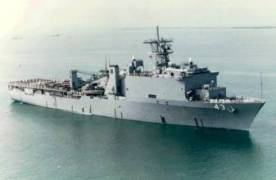 | 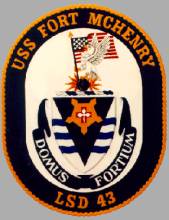 | 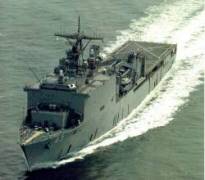 |
USS FORT McHENRY was the third WHIDBEY ISLAND class dock landing ship. In April 2006, the USS TORTUGA (LSD 46) replaced the USS FORT McHENRY as a forward deployed naval unit in Sasebo, Japan. The hull swap was part of the Navy's long-range plan to routinely replace older ships assigned to the Navy's Forward Deployed Naval Force with newer or more capable ships. TORTUGA's crew brought the McHENRY back to Little Creek, Va.
On March 27, 2021 - after more than 33 1/2 years of service - FORT McHENRY's crew held a decommissioning ceremony at Naval Station Mayport, Fla. On April 16, 2021, the ship was officially placed "out of commission, in reserve". FORT McHENRY was subsequently towed to the former Philadelphia Naval Shipyard for lay-up.
| General Characteristics: | Awarded: January 27, 1983 |
| Keel laid: June 10, 1983 | |
| Launched: February 1, 1986 | |
| Commissioned: August 8, 1987 | |
| Decommissioned: April 16, 2021 | |
| Builder: Lockheed Shipbuilding, Seattle, Wash. | |
| Propulsion system: four Colt Industries 16 Cylinder Diesels | |
| Propellers: two | |
| Length: 610 feet (186 meters) | |
| Beam: 84 feet (25.6 meters) | |
| Draft: 21 feet (6.4 meters) | |
| Displacement: approx. 16,000 tons full load | |
| Speed: 22 knots | |
| Well deck capacity: four LCAC or 21 LCM-6 (on deck: one LCM-6, two LCPL and one LCVP) | |
| Aircraft: none, but two landing spots allow for operation of aircraft as large as the | |
| Crew: Ship: 20 Officers, 25 Chief Petty Officers, 302 Enlisted | |
| Marine Detachment: approx. 400 + approx. 100 surge | |
| Armament: two | |
| Cost: $272 million |
Crew List:
This section contains the names of sailors who served aboard USS FORT McHENRY. It is no official listing but contains the names of sailors who submitted their information.
USS FORT McHENRY Cruise Books:
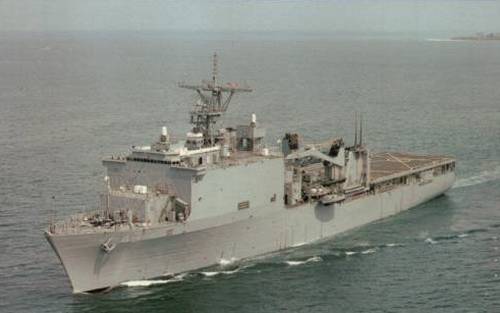
About the Ship’s Name, about Fort McHenry:
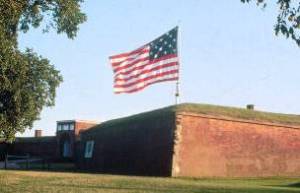 The history of the fort begins in 1776 during the Revolutionary War. The people of Baltimore feared an attack by the British and wanted a fort for protection. Anticipating an attack at any time, a set of earthen mounds was quickly constructed. Originally, it was called Fort Whetstone, because of its location on Whetstone Point.
The history of the fort begins in 1776 during the Revolutionary War. The people of Baltimore feared an attack by the British and wanted a fort for protection. Anticipating an attack at any time, a set of earthen mounds was quickly constructed. Originally, it was called Fort Whetstone, because of its location on Whetstone Point.
Although the Revolutionary War ended without an attack on Baltimore, improvements to the fort continued. In 1798, a French engineer was directed by the Secretary of War to draw plans for a new fort on Whetstone Point. These plans were expensive, and it was difficult for the people of Baltimore to raise money for construction. However, James McHenry, a well-known politician, was instrumental in raising funds for the new fort. The fort was renamed "Fort McHenry" in his honor.
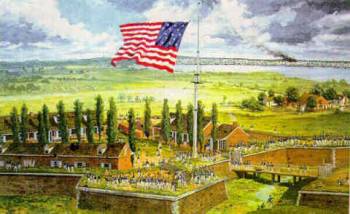 Fort McHenry became famous when the British tried to attack Baltimore during the War of 1812. When the bombardment began on 13 September 1814, there were 1000 soldiers defending the fort. Their commanding officer was Major George Armistead.
Fort McHenry became famous when the British tried to attack Baltimore during the War of 1812. When the bombardment began on 13 September 1814, there were 1000 soldiers defending the fort. Their commanding officer was Major George Armistead.
Just prior to the attack, Francis Scott Key met the Royal Navy in Chesapeake Bay to affect the release of Dr. William Beanes, a British prisoner and close friend of Key. Dr. Beanes was released, but the Americans were forced to wait in their boat behind the British fleet until the attack was completed. From a distance of approximately eight miles, Key and his friends watched the British bombard Fort McHenry.
After 25 hours of continuous bombing, the British decided to leave since they were unable to destroy the fort. Realizing the British had ceased the attack, Key looked toward the fort to see if the flag was still there. To his relief, the flag was still flying! Quickly, he wrote down the words to a poem that was soon handed out as a handbill under the title, "Defence of Fort McHenry". Later, the words were set to music, and renamed, "The Star Spangled Banner". This became a popular patriotic song, and in 1931 it became the United States’ national anthem.
History of USS FORT MCHENRY:
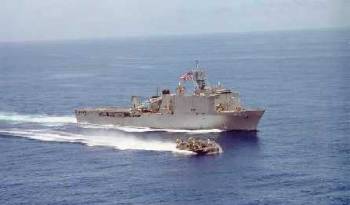 Named for the national monument in Baltimore, Maryland, USS FORT MCHENRY (LSD 43) is the third Whidbey Island Class Dock Landing Ship. FORT MCHENRY's keel was laid on 10 June 1983, and the ship was launched on 1 February 1986. The Honorable Helen D. Bently was the sponsor for FORT MCHENRY's commissioning ceremony which took place in Seattle, Washington on 8 August 1987.
Named for the national monument in Baltimore, Maryland, USS FORT MCHENRY (LSD 43) is the third Whidbey Island Class Dock Landing Ship. FORT MCHENRY's keel was laid on 10 June 1983, and the ship was launched on 1 February 1986. The Honorable Helen D. Bently was the sponsor for FORT MCHENRY's commissioning ceremony which took place in Seattle, Washington on 8 August 1987.
FORT MCHENRY's maiden deployment was from June 1988 to December 1988 to the Western Pacific. Following her return, FORT MCHENRY participated in the cleanup of the EXXON VALDEZ oil spill by deploying to Prince William Sound from 28 April to 22 June 1989. In recognition of the crew's effectiveness during the cleanup operation, FORT MCHENRY was awarded the Meritorious Unit Commendation and the Coast Guard's Special Operations Service Ribbon.
On 20 June 1990, FORT MCHENRY began her second deployment which was scheduled to be a six-month deployment to the Western Pacific. The Iraqi invasion of Kuwait on 2 August 1990 altered the schedule and resulted in a 10-month Desert Shield/Desert Storm deployment. Following her return to San Diego on 17 April 1991, FORT MCHENRY was awarded the Navy Unit Commendation, National Defense Service Medal, Southwest Asia Service Medal, Kuwait Liberation Medal and the Combat Action Ribbon for operations conducted in the North Arabian Gulf during Desert Storm.
Eight months after returning from her second deployment, FORT MCHENRY deployed again on 6 January 1992. After several successful multinational exercises and port visits, FORT MCHENRY returned to San Diego on 6 July 1992.
Following an extensive overhaul period, FORT MCHENRY began the training cycle to prepare for her next deployment. While in the training cycle, FORT MCHENRY transited to the east coast through the Panama Canal to pick up five new LCACs from Panama City, Florida. At the completion of the training cycle, FORT MCHENRY embarked on her fourth deployment from 9 June to 9 December 1994. While deployed, FORT MCHENRY participated in Operation Restore Hope by supporting the relocation of the United States Liaison Office from Somalia to Kenya. She also participated in Operation Vigilant Warrior, The United States' response to renewed Iraqi aggression against Kuwait. Following the deployment, FORT MCHENRY was awarded her second Navy Unit Commendation and Armed Forces Expeditionary Medal and also received her fourth Battle Efficiency Award.
On 1 September 1995, FORT MCHENRY departed San Diego for the last time as she became one of the forward deployed units of the Seventh Fleet homeported in Sasebo, Japan. During her first year in Japan, FORT MCHENRY participated in several training exercises in the Southeast Pacific. Also during that year, FORT MCHENRY had the rare opportunity to visit Shanghai, People's Republic of China on a goodwill mission to foster military ties with the Chinese.
During FORT MCHENRY's second full year in Japan, she participated in several multinational exercises designed to promote interoperability between U.S. and foreign forces. In February 1997 she departed for Brisbane, Australia to participate in Tandem Thrust, a combined U.S. and Australian command post and field training exercise. In June 1997, FORT MCHENRY transited to Pattaya, Thailand to take part in exercise Cobra Gold with elements of the Thai military. In October 1997 FORT MCHENRY departed for South Korea to conduct exercise Foal Eagle with amphibious forces from the Republic of Korea.
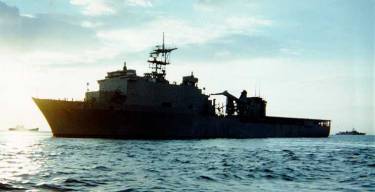 On 8 May 1998, following an extensive dry dock period, FORT MCHENRY embarked on Cooperation and Readiness Afloat Training (CARAT 98). CARAT was a series of exercises conducted by the U.S. and several countries in the Western Pacific. During the three-month cruise, FORT MCHENRY trained with forces from, and made goodwill port visits to Brunei, Singapore, Malaysia and Thailand. On June 1 1998, FORT MCHENRY received the Commander, Naval Surface Pacific Fleet Wellness Unit Award for 1997 and the Chief of Naval Operations Award for 1997. FORT MCHENRY concluded 1998 by participating in exercise FOAL EAGLE off the Coast of South Korea.
On 8 May 1998, following an extensive dry dock period, FORT MCHENRY embarked on Cooperation and Readiness Afloat Training (CARAT 98). CARAT was a series of exercises conducted by the U.S. and several countries in the Western Pacific. During the three-month cruise, FORT MCHENRY trained with forces from, and made goodwill port visits to Brunei, Singapore, Malaysia and Thailand. On June 1 1998, FORT MCHENRY received the Commander, Naval Surface Pacific Fleet Wellness Unit Award for 1997 and the Chief of Naval Operations Award for 1997. FORT MCHENRY concluded 1998 by participating in exercise FOAL EAGLE off the Coast of South Korea.
In January of 1999, FORT MCHENRY made her second port visit to Hong Kong since the island’s return to Chinese rule in 1997. In February 1999, FORT MCHENRY began the 1999 competitive training cycle and spent much of the month conducting exercises in South Korea with the ROK military and training independently in the South China Sea. On 16 February, Fort MCHENRY received her fifth Battle Efficiency Award recognizing excellence in Maritime Warfare, Combat and Control, Logistics Management and Engineering and Survivability during the 1998 training cycle.
From 8 through 12 March, 1999, FORT MCHENRY underwent Command Assessment Readiness Training (CART II). During the five-day assessment, Afloat Training Group Western Pacific and the Propulsion Evaluation Board assessed FORT MCHENRY’S effectiveness in all areas of shipboard readiness.
On March 15 1999, FORT MCHENRY transited to Guam and the Northern Marianas Islands to participate in exercise Tandem Thrust 99 (TT-99), an combined exercise designed to develop interoperabilty between forces from several nations during emergency contingency planning situations. During the exercise, FORT MCHENRY and the embarked Marines of the Marine Air-Ground Task Force for TT-99 trained with elements from all branches of the U.S. military, the Australian Defense Force, and forces from Canada and Singapore.
In April 2006, the USS TORTUGA (LSD 46) replaced the USS FORT MCHENRY as a forward deployed naval unit in Sasebo, Japan. The hull swap was part of the Navy's long-range plan to routinely replace older ships assigned to the Navy's Forward Deployed Naval Force with newer or more capable ships. TORTUGA's crew brought the MCHENRY back to Little Creek, Va.
USS FORT McHENRY Image Gallery:
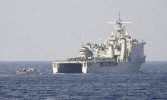 | 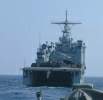 | 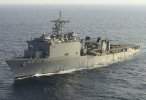 | 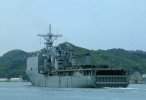 | 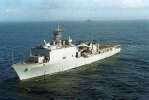 |
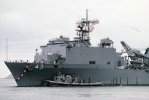 | 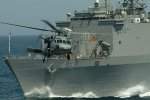 |  |
The photo below was taken by me and shows the FORT McHENRY dry-docked at Norfolk, Va., on October 27, 2010.
 |
The photos below were taken by me and show the worn down FORT McHENRY leaving Kiel, Germany, to participate in BALTOPS 2019 in the Baltic Sea on June 9, 2019. The FORT McHENRY deployed from Mayport, Fla., on December 12, 2018, and spent the majority of the deployment in Middle Eastern waters. During this time, the crew was quarantined at sea for 110 consecutive days due to viral mumps outbreak on board.
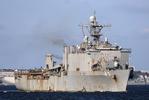 | 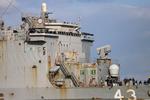 | 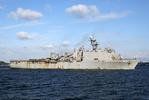 | 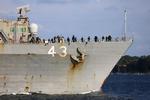 | 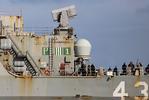 |
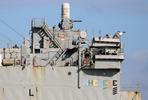 |  | 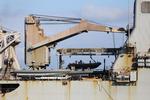 | 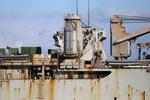 | 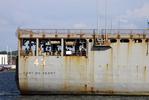 |
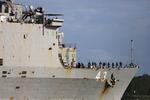 | 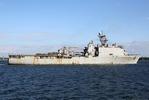 | 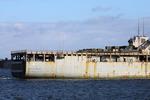 | 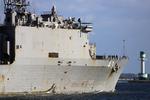 |  |
 | 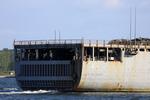 | 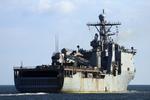 |
The photos below were taken by Michael Jenning and show the decommissioned FORT McHENRY laid up at Philadelphia, Penn., on May 27, 2022.
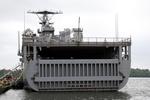 | 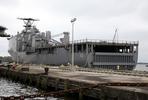 | 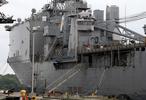 | 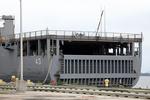 |
 Back to Dock Landing Ship site.
Back to Dock Landing Ship site.  Back to ships list.
Back to ships list.  Back to selection page.
Back to selection page.  Back to 1st page.
Back to 1st page.